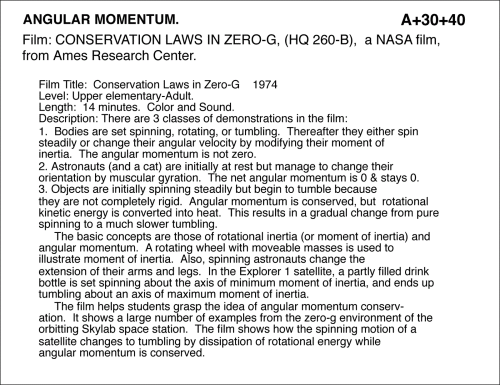Film: "Conservation laws in zero G", sound, 14 min..
Primary tabs
Film: CONSERVATION LAWS IN ZERO-G, (HQ 260-B), a NASA film, from Ames Research Center. Film Title: Conservation Laws in Zero-G 1974 Level: Upper elementary-Adult. Length: 14 minutes. Color and Sound. Description: There are 3 classes of demonstrations in the film: 1. Bodies are set spinning, rotating, or tumbling. Thereafter they either spin steadily or change their angular velocity by modifying their moment of inertia. The angular momentum is not zero. 2. Astronauts (and a cat) are initially at rest but manage to change their orientation by muscular gyration. The net angular momentum is 0 & stays 0. 3. Objects are initially spinning steadily but begin to tumble because they are not completely rigid. Angular momentum is conserved, but rotational kinetic energy is converted into heat. This results in a gradual change from pure spinning to a much slower tumbling. The basic concepts are those of rotational inertia (or moment of inertia) and angular momentum. A rotating wheel with moveable masses is used to illustrate moment of inertia. Also, spinning astronauts change the extension of their arms and legs. In the Explorer 1 satellite, a partly filled drink bottle is set spinning about the axis of minimum moment of inertia, and ends up tumbling about an axis of maximum moment of inertia. The film helps students grasp the idea of angular momentum conservation. It shows a large number of examples from the zero-g environment of the orbitting Skylab space station. The film shows how the spinning motion of a satellite changes to tumbling by dissipation of rotational energy while angular momentum is conserved.
UCB Index:
A+30+40
UCB Taxonomy:
Popularity:
Previous:
- Log in to post comments

